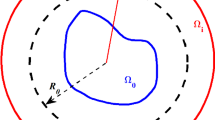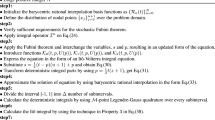Abstract
In the present paper, the spectral meshless radial point interpolation (SMRPI) technique is applied to the solution of pattern formation in nonlinear reaction diffusion systems. Firstly, we obtain a time discrete scheme by approximating the time derivative via a finite difference formula, then we use the SMRPI approach to approximate the spatial derivatives. This method is based on a combination of meshless methods and spectral collocation techniques. The point interpolation method with the help of radial basis functions is used to construct shape functions which act as basis functions in the frame of SMRPI. In the current work, to eliminate the nonlinearity, a simple predictor–corrector (P–C) scheme is performed. The effect of parameters and conditions are studied by considering the well-known Schnakenberg model.








Similar content being viewed by others
References
Zhu J, Zhang Y-T, Newman SA, Alber M (2009) Application of discontinuous Galerkin methods for reaction-diffusion systems in developmental biology. J Sci Comput 40(1–3):391–418
Turing AM (1952) The chemical basis of morphogenesis. Philos Trans R Soc Lond Ser B Biol Sci 237(641):37–72
Gierer A, Meinhardt H (1972) A theory of biological pattern formation. Kybernetik 12(1):30–39
Prigogine I, Lefever R (1968) Symmetry breaking instabilities in dissipative systems. II. J Chem Phys 48(4):1695–1700
Schnakenberg J (1979) Simple chemical reaction systems with limit cycle behaviour. J Theor Biol 81(3):389–400
Thomas D (1975) Artificial enzyme membranes, transport, memory, and oscillatory phenomena. In: Thomas D, Kernevez JP (eds) Analysis and control of immobilized enzyme systems. Springer, Berlin, Heidelberg, New York, pp 115–150
Gray P, Scott SK (1983) Autocatalytic reactions in the isothermal, continuous stirred tank reactor: isolas and other forms of multistability. Chem Eng Sci 38(1):29–43
Gray P, Scott SK (1984) Autocatalytic reactions in the isothermal, continuous stirred tank reactor: oscillations and instabilities in the system A+ 2B\(\rightarrow\) 3B; B\(\rightarrow\) C. Chem Eng Sci 39(6):1087–1097
Aragón JL, Torres M, Gil D, Barrio RA, Maini PK (2002) Turing patterns with pentagonal symmetry. Phys Rev E 65(5):051913
Aragón JL, Varea C, Barrio RA, Maini PK (1998) Spatial patterning in modified turing systems: application to pigmentation patterns on marine fish. Forma 13(3):213–221
Barrio RA, Varea C, Aragón JL, Maini PK (1999) A two-dimensional numerical study of spatial pattern formation in interacting turing systems. Bull Math Biol 61(3):483–505
Barrio RA, Maini PK, Aragón JL, Torres M (2002) Size-dependent symmetry breaking in models for morphogenesis. Phys D Nonlinear Phenom 168:61–72
Shirzadi A, Sladek V, Sladek J (2013) A local integral equation formulation to solve coupled nonlinear reaction-diffusion equations by using moving least square approximation. Eng Anal Bound Elem 37(1):8–14
Murray JD (1993) Mathematical biology. Springer, Heidelberg
Hundsdorfer W, Verwer JG (2013) Numerical solution of time-dependent advection-diffusion-reaction equations. Springer Science & Business Media, New York
Kernevez JP, Thomas D (1975) Numerical analysis and control of some biochemical systems. Appl Math Optim 1(3):222–285
Dehghan M, Abbaszadeh M, Mohebbi A (2016) The use of element free Galerkin method based on moving Kriging and radial point interpolation techniques for solving some types of Turing models. Eng Anal Bound Elem 62:93–111
Twizell EH, Gumel AB, Cao Q (1999) A second-order scheme for the Brusselator reaction–diffusion system. J Math Chem 26(4):297–316
Madzvamuse A, Maini PK (2007) Velocity-induced numerical solutions of reaction-diffusion systems on continuously growing domains. J Comput Phys 225(1):100–119
Shakeri F, Dehghan M (2011) The finite volume spectral element method to solve turing models in the biological pattern formation. Comput Math Appl 62(12):4322–4336
Madzvamuse A, Chung AHW (2014) Fully implicit time-stepping schemes and non-linear solvers for systems of reaction–diffusion equations. Appl Math Comput 244:361–374
Sladek V, Sladek J, Shirzadi A (2015) The local integral equation method for pattern formation simulations in reaction–diffusion systems. Eng Anal Bound Elem 50:329–340
Campagna R, Cuomo S, Giannino F, Severino G, Toraldo G (2018) A semi-automatic numerical algorithm for turing patterns formation in a reaction-diffusion model. IEEE Access 6:4720–4724
Campagna R, Brancaccio M, Cuomo S, Mazzoleni S, Russo L, Siettos K, Giannino F (2017) Numerical approaches to model perturbation fire in turing pattern formations. In: AIP conference proceedings, vol 1906, p 100011. AIP Publishing
Burrage K, Hale N, Kay D (2012) An efficient implicit FEM scheme for fractional-in-space reaction-diffusion equations. SIAM J Sci Comput 34(4):A2145–A2172
Zhuang P, Liu F, Turner I, YuanTong G (2014) Finite volume and finite element methods for solving a one-dimensional space-fractional Boussinesq equation. Appl Math Model 38(15):3860–3870
Katsikadelis JT (2011) The BEM for numerical solution of partial fractional differential equations. Comput Math Appl 62(3):891–901
Fasshauer GE (2007) Meshfree approximation methods with MATLAB, vol 6. World Scientific, Singapore
Fasshauer GE, Zhang JG (2007) On choosing optimal shape parameters for RBF approximation. Numer Algorithms 45(1–4):345–368
Shivanian E, Jafarabadi A (2017) Numerical solution of two-dimensional inverse force function in the wave equation with nonlocal boundary conditions. Inverse Probl Sci Eng 25(12):1743–1767
Shivanian E, Jafarabadi A (2018) An inverse problem of identifying the control function in two and three-dimensional parabolic equations through the spectral meshless radial point interpolation. Appl Math Comput 325:82–101
Shivanian E, Jafarabadi A (2017) Error and stability analysis of numerical solution for the time fractional nonlinear Schrödinger equation on scattered data of general-shaped domains. Numer Methods Partial Differ Equ 33(4):1043–1069
Jafarabadi A, Shivanian E (2018) Numerical simulation of nonlinear coupled Burgers equation through meshless radial point interpolation method. Eng Anal Bound Elem 95:187–199
Wendland H (1998) Error estimates for interpolation by compactly supported radial basis functions of minimal degree. J Approx Theory 93(2):258–272
Shivanian E (2015) A new spectral meshless radial point interpolation (SMRPI) method: a well-behaved alternative to the meshless weak forms. Eng Anal Bound Elem 54:1–12
Shivanian E, Jafarabadi A (2017) Inverse Cauchy problem of annulus domains in the framework of spectral meshless radial point interpolation. Eng Comput 33(3):431–442
Dehghan M, Ghesmati A (2010) Numerical simulation of two-dimensional sine-Gordon solitons via a local weak meshless technique based on the radial point interpolation method (RPIM). Comput Phys Commun 181(4):772–786
Acknowledgements
The authors are grateful to the reviewers for carefully reading this paper and for their comments and suggestions which have improved the paper. The authors also acknowledge financial support from the Imam Khomeini International University project IKIU-11829.
Author information
Authors and Affiliations
Corresponding author
Additional information
Publisher's Note
Springer Nature remains neutral with regard to jurisdictional claims in published maps and institutional affiliations.
Rights and permissions
About this article
Cite this article
Shivanian, E., Jafarabadi, A. Turing models in the biological pattern formation through spectral meshless radial point interpolation approach. Engineering with Computers 36, 271–282 (2020). https://doi.org/10.1007/s00366-018-00698-6
Received:
Accepted:
Published:
Issue Date:
DOI: https://doi.org/10.1007/s00366-018-00698-6




